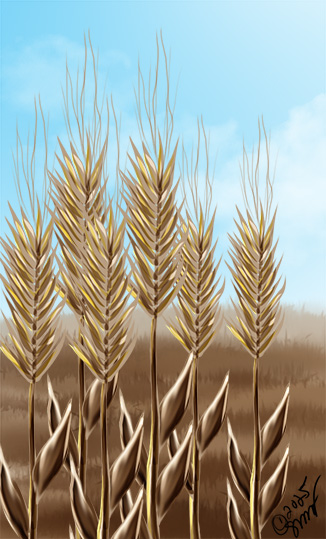Harvesting Esapan
You must harvest the esapan with a greybark sickle and your hands. Hold the heads and leaves just above the stem. Strike at an angle, so the tops ooze white liquid; this is collected by esaban milkmaids and made into esaban paste.
Take the esaban and place the cut heads into a snowgrass wicker basket--and it has to be snowgrass, because snowgrass won't contaminate the esaban with strange tastes.
Harvesting Esapan:
All artwork by Shade Melodique
unless otherwise stated
unless otherwise stated
Esapan Harvest
Esapan comes in golden, midnight, sky, bark, and curled varieties. Only the golden variety has a complicated ritual associated with its harvest. Some of this is due to the white liquid that leaks from the stalks after the heads are removed. Called golden milk, you need to cut the stalk in the right place to extract the maxiumum amount of it. Too high, too low, and you might not get any from that specific plant. As golden milk is an ingredient in a bready biscuit used to honor the Lady of the Green Fingers, and each plant only gives a small amount, getting the cut right is important. The rest has religious significance, as the way golden is harvested mimics that of the mythic first Barik Fena farmers. They supposedly received the instruction from the Lady of the Green Fingers herself, and no one wants to disregard a sylfaone's words.The Ritual
Farmers harvest every field of golden esapan in the same way, even though modern farming equipment or a Greenroot specialist could do so quicker. Fast isn't the motivation; extracting golden milk is. The ritual starts with the dawn, but the sun must be over the horizon, transitioning into morning (around the seventh moonmark). From there, the southernmost row is harvested first. The farmer and his helpers grab the heads of the grain, cut them off at a slant, and place them in a snowgrass wicker basket (which, despite insistence, has nothing to do with the taste of the esapan, and everything to do with its ubiquitous nature). Behind the harvesters come the golden milkmaids. They work in pairs; one bends the stalk so the cut tip drips into a white ceramic bowl, while the other pinches the base of the stalk and pushes the milk upwards to the tip. They extract a spoon's worth of milk before going to the next stalk. Bringing up the rear are mountain noxyen. They feed off the stalks, which supposedly gives them stronger muscles and sleeker hides, and makes for better meat, milk and leather. Any dung left in the fields is mixed into fertilizer for the next harvest.
A greybark sickle is always used to cut the heads of esapan. Greybark is a common tree along the eastern seaboard, and the blade is made from a hard, sharp stone called a caver (because it's mined from caves).
Priests for the Lady of Green Fingers craft the sickles using traditional bending and knapping methods, and they are the only individuals from whom farmers can purchase the tools.
Local temples pay for their upkeep by selling these special items.
Once filled, farmers carry the baskets to small carts pulled by a stocky mountain pony called a rockhoof. The driver walks beside the pony and sings praises to Lady of the Green Fingers for her bounty (even if it's not much of a bounty due to pestilence or flood) and only ends the song once they reach the shuckers.
Shuckers shuck in special sheds attached to Green Finger temples. They peel the leaves and beards from the heads and separate the kernels from the chaff.
Then the kernels are put into fresh snowgrass baskets and taken to the priestly millers, who grind the esapan into flour using two large, flat-sided field stones, the top of which is rotated by way of a central handle. Flautists play harvest songs during the milling, and the millers sing accompaniment. There is no specific set of songs, so whatever strikes the musicians' fancy gets heard. Singing is supposed to make the flour sweet.
After the milling, the flour is placed in large white ceramic bowls and presented to the head priest of the temple to bless. Afterwards the flour is given back to the farmer to do with as they see fit.
Fieldstone milling is credited to the Lady of Green Fingers, who gave her people a better way than mortar and pestle to make flour.
While traditional, the use of the fieldstones is economical as well; the priests do not charge for this service, as it is said to upset the Lady. This keeps golden esapan cheap enough, the poorest commoners can afford to purchase the flour for golden noodles.




Comments